
Norway - other historic railways
For a full scale picture, please click on the picture shown !
Gamle Vossebanen
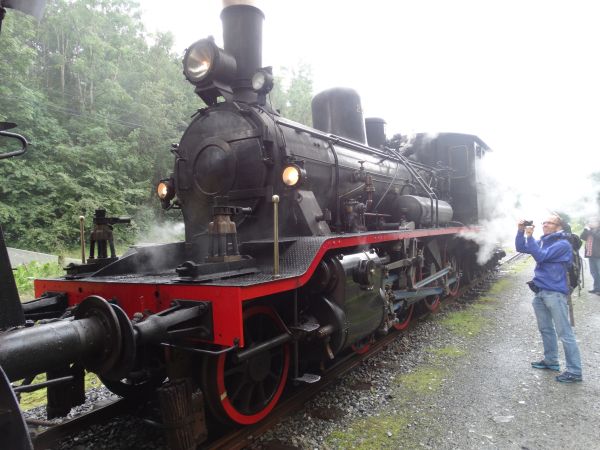
Beyond Norway's national museum for railways in Hamar, there are also a number of
interesting other museum trains and train museums in Norway. This part of our archive is devoted to old Norwegian railways beyond the
national railway museum.
Our first picture shows a class 82 steam locomotive of the Gamle Vossebanen (old river rapids railroad) from 1913 near the city of Bergen.
A more thorough explanation of the site can be found below.
Photo from Midttun near Bergen 3.7.2016 by Ilkka Siissalo.
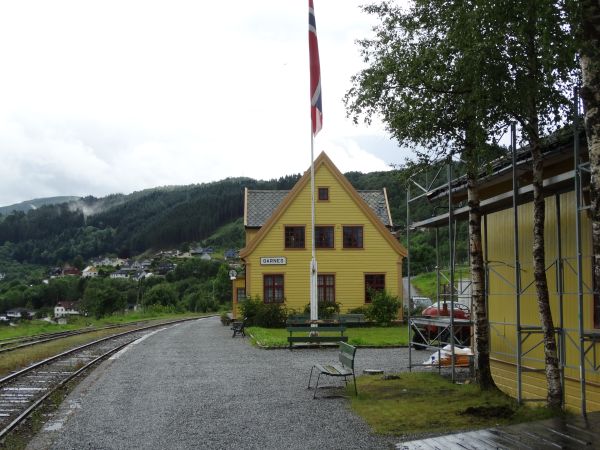
The Gamle Vossebanen museum railway near Bergen is Norway's only museum railroad which runs on a dedicated main line. The route runs from
Garnes to Midtun on the route which once was a part of the Oslo to Bergen main line. The route is 18 km long and it takes
50 minutes for the museum train to run through the whole route. There are two old stations in between, Arna and Haukeland.
The museum trains are operated by NJK, Norsk Jernbaneklubb (Norwegian Railways Club) and run on summer weekends. There is some very nice scenery
along the line.
Garnes station pictured here is the other endpoint and operations center of the Gamle Vossebanen museum railway.
Picture 3.7.2016 by Ilkka Siissalo.
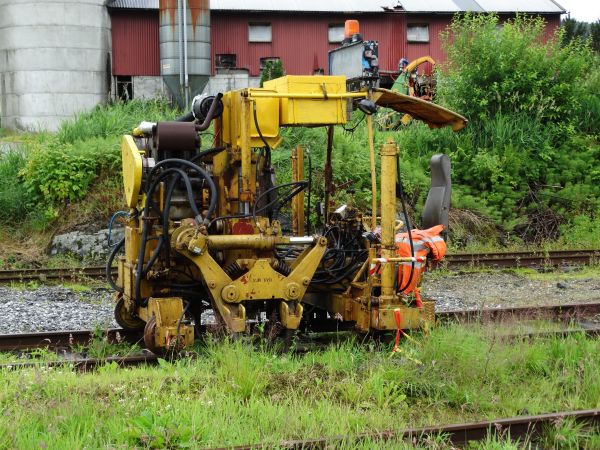
A small sleeper changer machine at the Garnes station. It had been lately in use in the renewal of rotten old wooden sleepers under the tracks.
Picture 3.7.2016 at Garnes by Ilkka Siissalo.
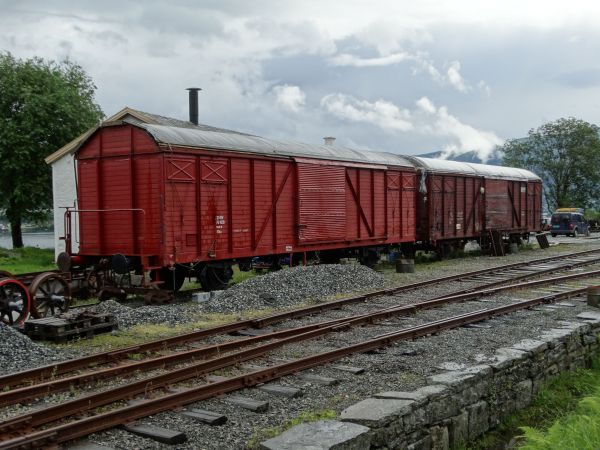
Two old littera Gbs cargo wagons at Garnes.
Picture 3.7.2016 at Garnes by Ilkka Siissalo.
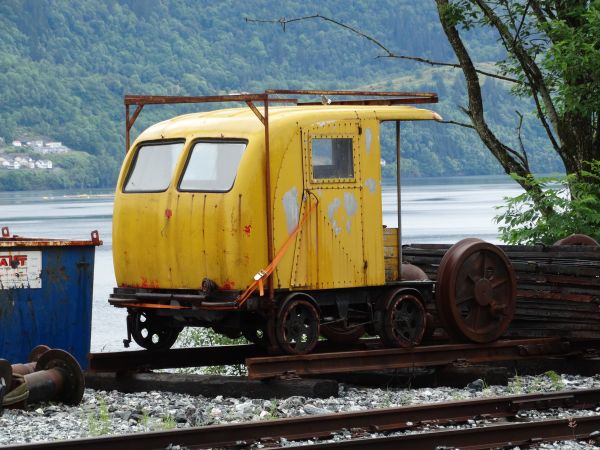
If somebody knows what exactly this is, please tell us. All we see is that it is a very old motorised draisine waiting for restoration.
Picture 3.7.2016 at Garnes by Ilkka Siissalo.
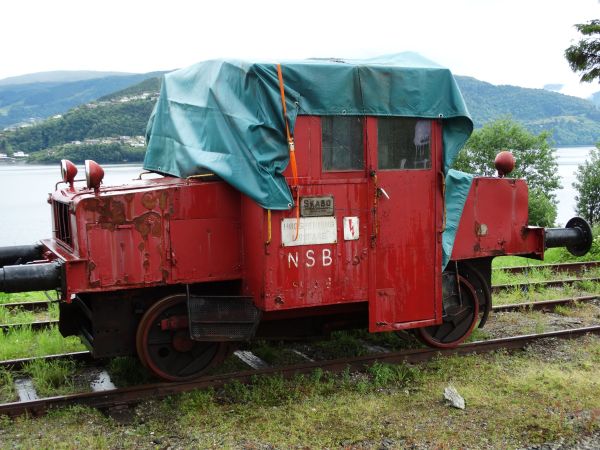
This is a small shunting tractor of the class SKD 206, which was built by three different factories in Norway 1936-39. They were in use
until 1980s at smaller stations. It would really need the
conservaton that it is clearly waiting for. This one was built by the company Skabo in Skøyen in 1939 and it became well known in Norway
due to being part of the famous film Olsen band and Dynamite-Harry. The picture also gives
a hint of the wonderful fjord scenery along the Gamle Vossebanen route.
Picture 3.7.2016 at Garnes by Ilkka Siissalo.
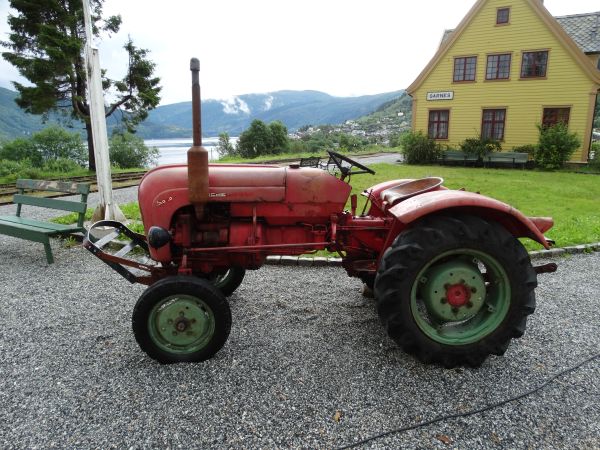
Yes, I know it is not a train picture, but I could not resist... sorry ! At least there is the Garnes station house in the background and
this tractor belongs to the Gamle Vossebanen museum railway. Our train photographer
Sanna Siissalo always says that she'd like to have a Porsche, so maybe this one would do? ;-)
Picture 3.7.2016 at Garnes by Ilkka Siissalo.
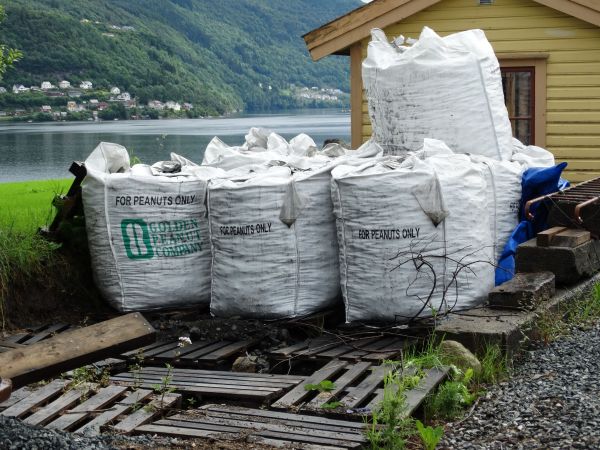
"For peanuts only". Sorry, it's not peanuts. It's coal for the steam locomotive of the Gamle Vossebanen train.
Picture 3.7.2016 at Garnes by Ilkka Siissalo.
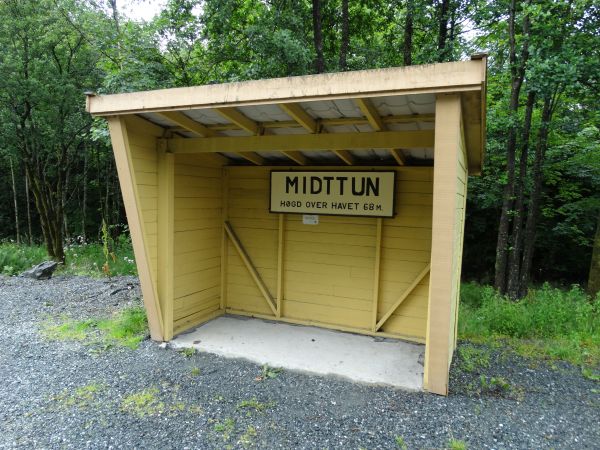
The "station" of Midtun is the other end of the museum train line. But there are two beautiful old stations in between the two endpoints.
Photo at Midttun near Bergen 3.7.2016 by Ilkka Siissalo.
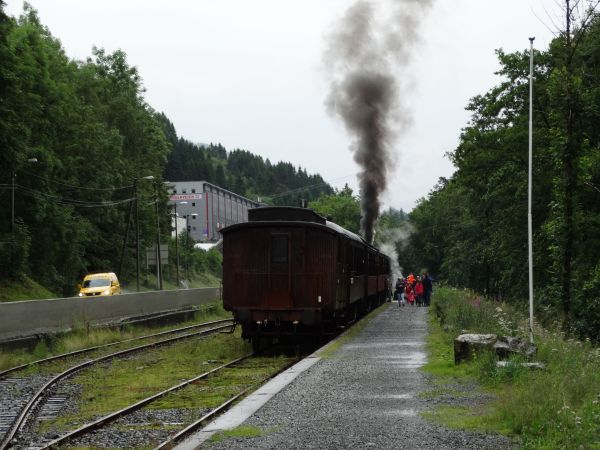
Two minutes until departure time, the Gamle Vossebanen museum train is ready to leave back towards Garnes.
Photo at Midtun near Bergen 3.7.2016 by Ilkka Siissalo.
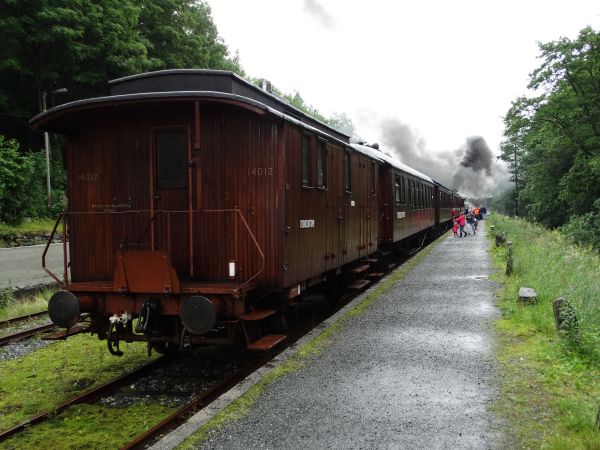
A pure 1930s express train. The last wagon is a conductor and cargo wagon, the next one after that is a "Sovevogn" = night train sleeper coach
(hardly necessary for a 50 minutes ride to Garnes :-) and the following ones are 2nd and 3rd class regular passenger coaches.
Photo from Midtun near Bergen 3.7.2016 by Ilkka Siissalo.
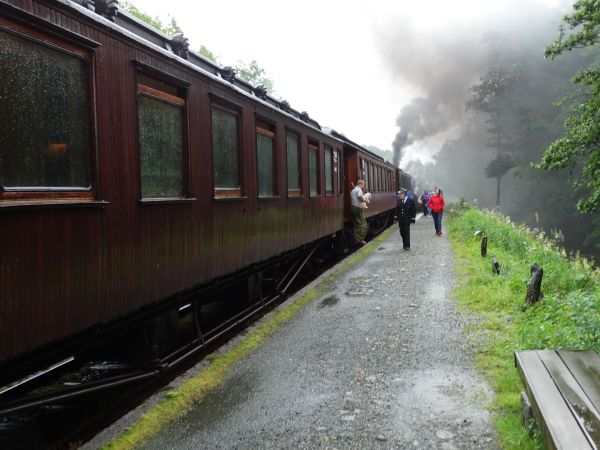
Is there still time to take the doggy for a quick piss? Oh yes... In the 1930s there was never such a hurry as today. Besides there were also
passengers who wanted to board the train and who wrongfully parked their cars where ever they could and sprang to catch the train,
which then finally left the station 7 minutes late - with the doggy and his hubby onboard :-)
Photo from Midtun near Bergen 3.7.2016 by Ilkka Siissalo.
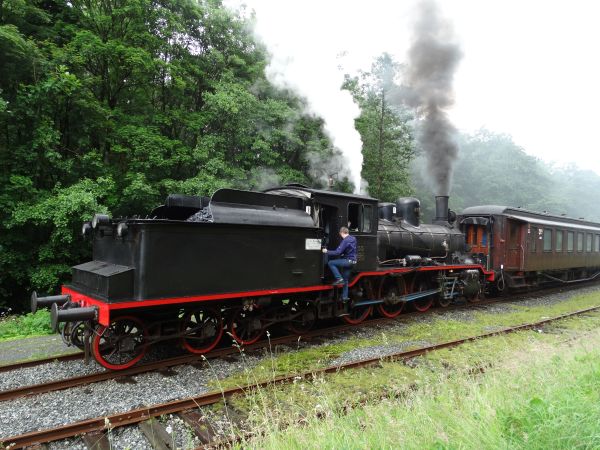
The heater climbs out of the class 82 locomotive from 1913 to make a final check.
Photo from Midtun near Bergen 3.7.2016 by Ilkka Siissalo.
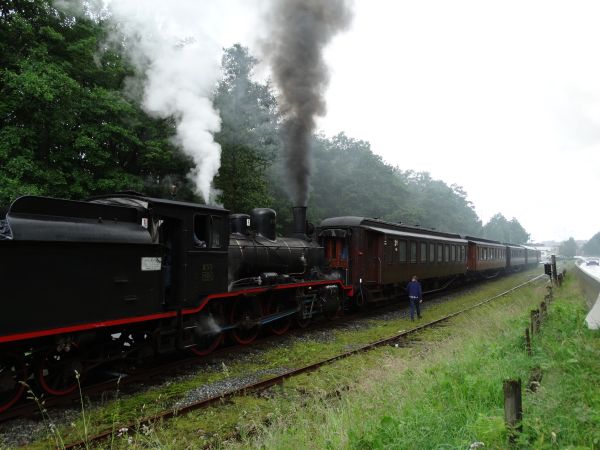
Final check of brakes before departure.
Photo from Midtun near Bergen 3.7.2016 by Ilkka Siissalo.
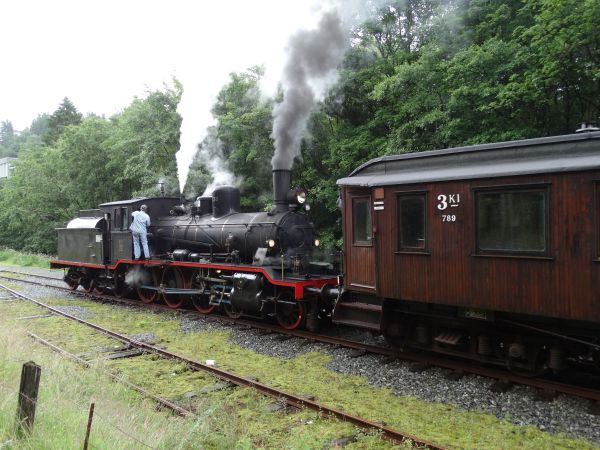
Still one more thing to fix before departure: The 1913 built locomotive has no wipers and there were too many insects, too much rain water
and too much coal/sod in the window screens to see properly. The driver had to do quite some climbing to reach all the relevant window screens.
Photo from Midtun near Bergen 3.7.2016 by Ilkka Siissalo.
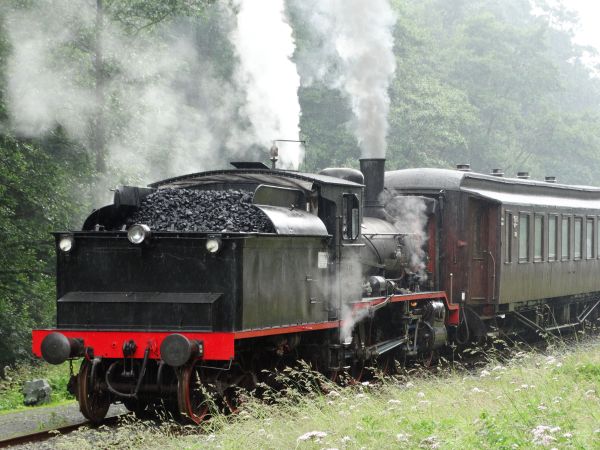
The whistle is blowing, finally time to go. Doggies, their hubbies and other latecomers all onboard !
Photo from Midtun near Bergen 3.7.2016 by Ilkka Siissalo.
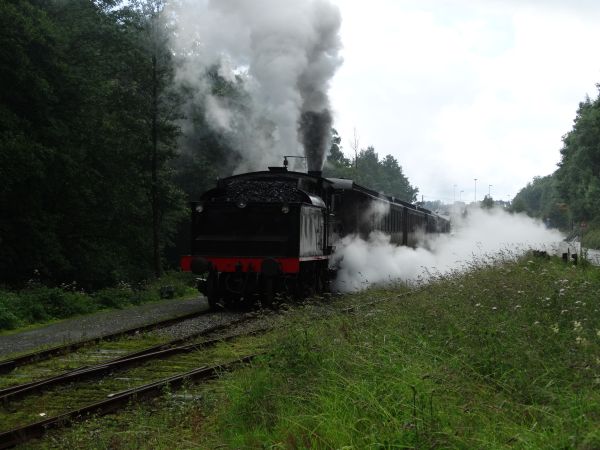
And the-eere it goees.... Chuuch-Tschuuch... Clumsy, noisy, smoky, dirty, slow, ugly... and yet some peculiar people love them.
Photo from Midtun near Bergen 3.7.2016 by Ilkka Siissalo.
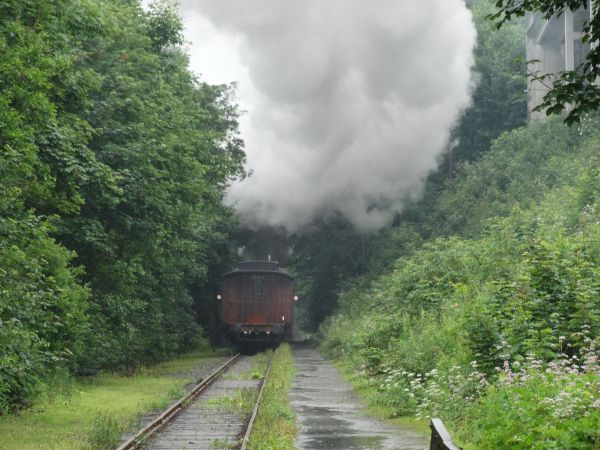
Bye-bye Gamle Vossebanen. See you next time !
Photo from Midtun near Bergen 3.7.2016 by Ilkka Siissalo.
Flåmsbana and the Flåmsbana museum
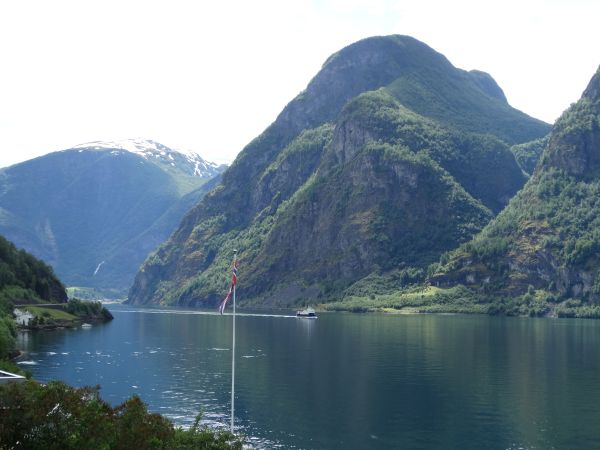
Flåm is nowadays one of Norways' premier touristic attractions. This is not a train photo, but it gives you a good impression of what it is all about.
Flåm lies a little north of the city of Bergen. Most of the thousands and thousands of tourists arrive either by bus or by boat along the Nærøyfjord
which you can see on the picture. The little village of Flåm lies at the very end of the fjord, where the small fjordship in this picture is coming from.
Flåm is connected to the outside world not only via ships and today a road, but also via a very spectacular railroad, the Flåmsbane. Most of the
thousands of tourists just take the train trip up and back down again, which takes about an hour. In the summertime the village of Flåm is a huge
touristic center, a melting pot of all nations and languages, and it makes big money by selling tourists all kinds of things. But the railroad is
really spectacular. And there is also a small museum showing some of the history of the Flåm railroad. In this section of our archive, we show some
bits and pieces of Flåm and that museum. The area together with its railway is listed on the Unesco World Heritage sites list.
Picture of Nærøyfjorden 2.7.2016 by Ilkka Siissalo.
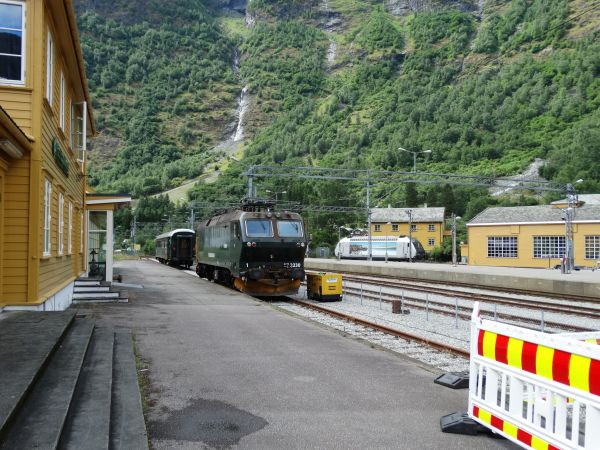
The trains of Flåmsbana are typically today composed of 1960s express train coaches painted dark green. At both ends of the train there has to be
a powerful locomotive. In the front of the picture you can see an NSB's class El 17 painted also dark green, which for a long time used to be the standard
machines here. But nowadays the standard locomotives are of the Swiss made class El 18, one of which you can see in the background. The house to the left
in the picture is the Flåmsbana museum.
Picture 2.7.2016 by Ilkka Siissalo.
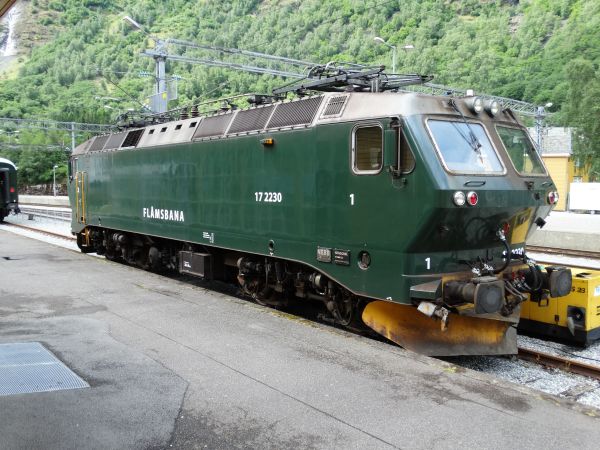
The NSB class El 17 was a fairly rare locomotive built by NEBB and the German company Henschel. The outer design is based on the Henschel made huge diesel
locomotives of the class Di 4, which - if you want - you can see in this archive at Norway -> diesel locomotives. Besides the Flåmsbana, EL 17 has all
but vanished, so today this picture may be regarded as something of a rarity.
Picture from Flåm 2.7.2016 by Ilkka Siissalo.
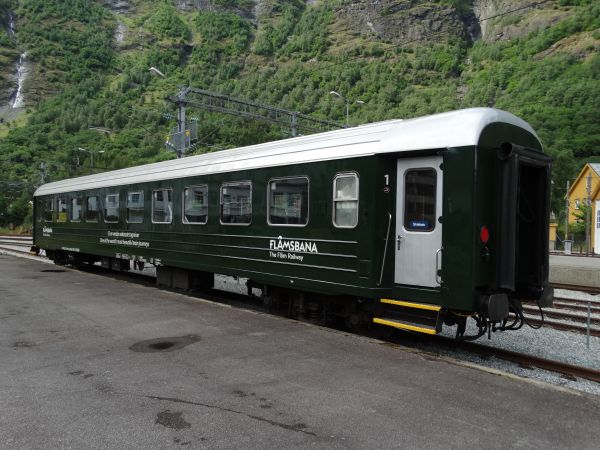
A typical coach of the Flåmsbana touristic railway of today is a common express train coach from the 1960s, not used anywhere else any more. But in NSB's
express train service they used to be painted reddish brown. A number of these same coaches have been sold to for example private operators in Sweden.
You can see some in our Swedish section, for example painted in silver/red colours of TÅGAB.
Picture from Flåm 2.7.2016 by Ilkka Siissalo.
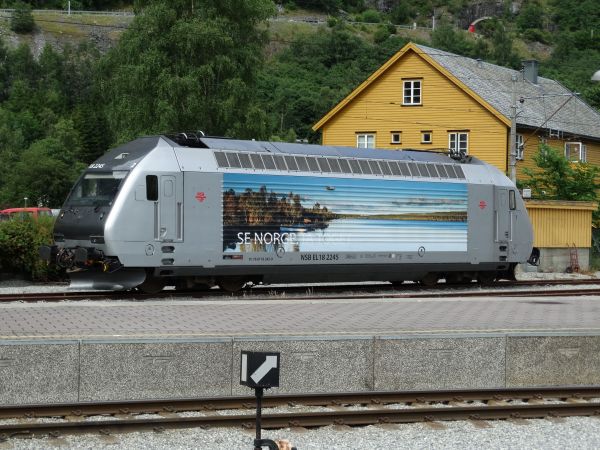
A typical locomotive of Flåmsbana today is El 18, built in Switzerland. Only for some some small details like the huge snowploughs needed in Norway, it is
almost identical to the Swiss SBB class 460 / BLS class 465 and almost identical to the Finnish class Sr2.
Picture from Flåm 2.7.2016 by Ilkka Siissalo.
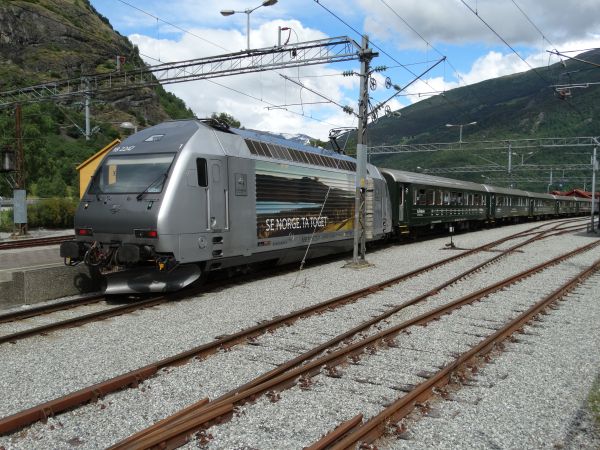
A typical Flåmsbana touristic train almost ready to leave, this time absolutely full packed with Spanish speaking tourists from a huge cruise ship.
This is big business.
Picture from Flåm 2.7.2016 by Ilkka Siissalo.
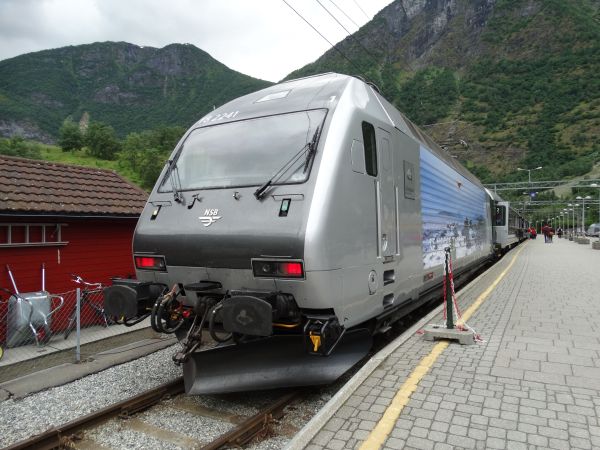
The El 18 is a modern and beautiful locomotive.
Picture from Flåm 2.7.2016 by Ilkka Siissalo.
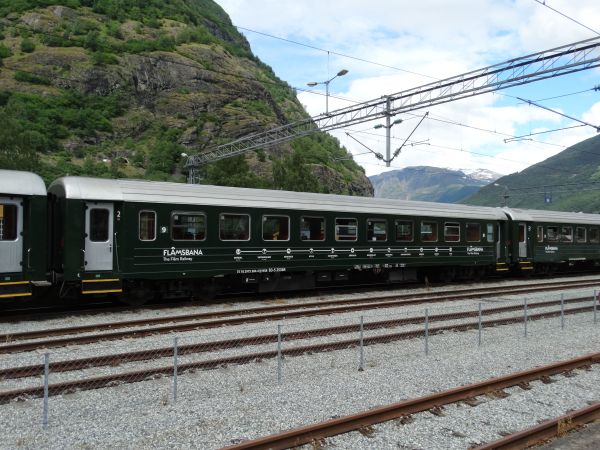
Some of the Flåmsbana coaches show even outside the names of major sightseeing attractions along the route. This is an empty train waiting for
tourists to board like a herd of cattle.
Picture from Flåm 2.7.2016 by Ilkka Siissalo.
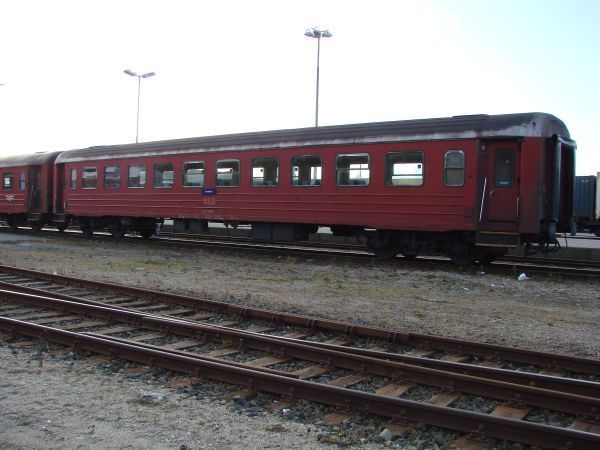
For comparison: These are the same 1960s coaches of the class B3, but in their original reddish brown livery, here seen in the very north in Bodø, forming
a diesel driven train to Trondheim.
Picture from Bodø 18.8.2009 by Ilkka Siissalo.
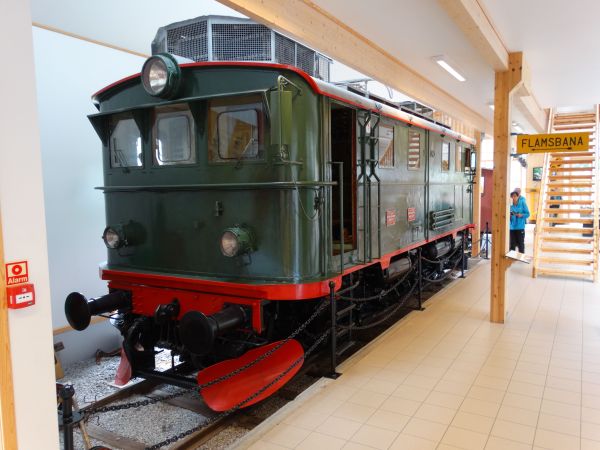
This is NSB's class El 9, which was the first electric locomotive specifically built for the difficult conditions of the Flåmsbana. It was built in 1944
by NEBB and Thunes mekaniske verksted. It had a top speed of 60 km/h.
Picture from Flåm, from the Flåmsbana museum 2.7.2016 by Ilkka Siissalo.
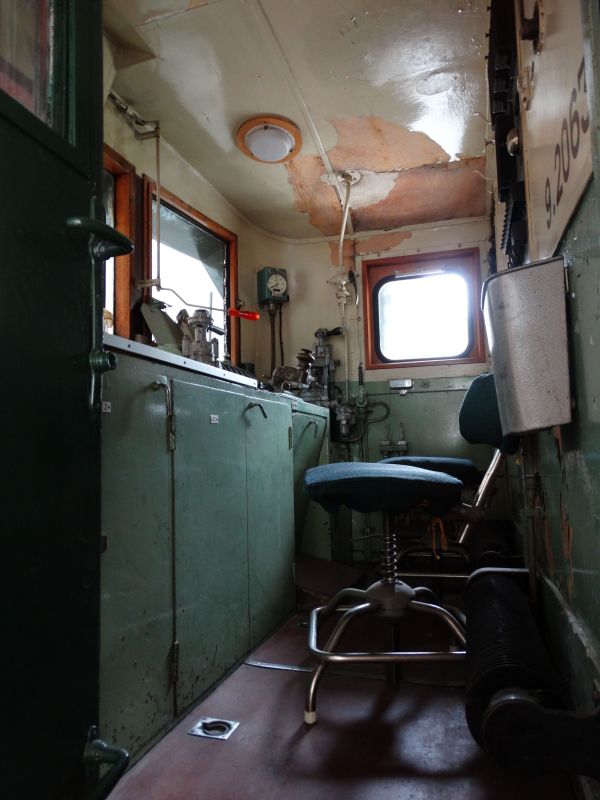
Driver's cab of the class El 9 engine from 1944.
Picture from Flåm, from the Flåmsbana museum 2.7.2016 by Ilkka Siissalo.
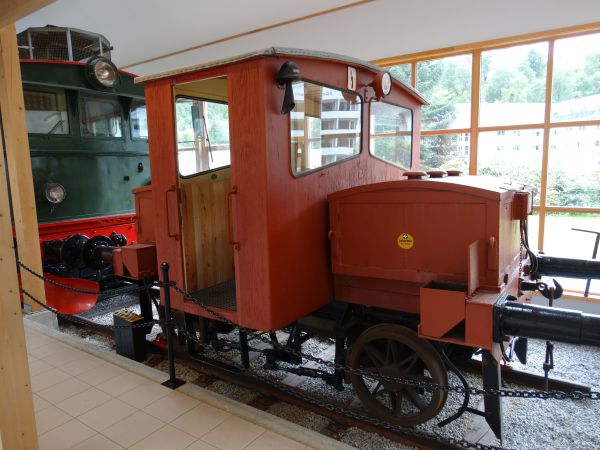
This is a rebuilt apparently battery driven old shunter locomotive kept at the Flåmsbana museum. Note the pipelines and sandboxes that would feed a constant
flow of sand in front of the driving wheels to increase friction.
Picture from Flåm, from the Flåmsbana museum 2.7.2016 by Ilkka Siissalo.
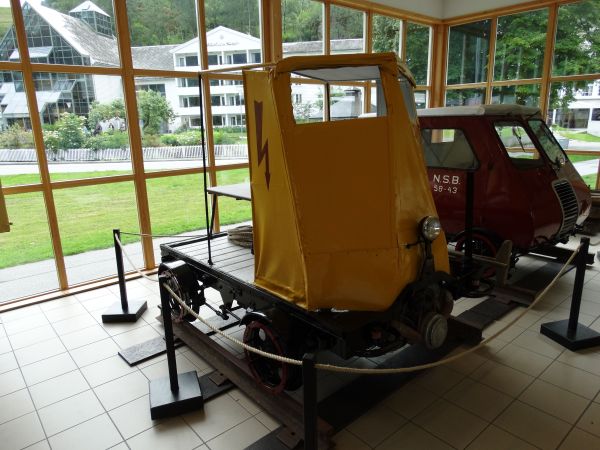
Motor draisines of old times at the Flåmsbanamuseum.
Picture from Flåm, from the Flåmsbana museum 2.7.2016 by Ilkka Siissalo.
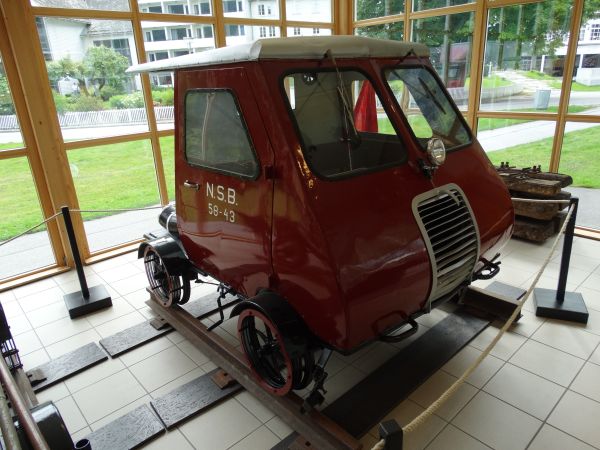
Motor draisine or rail inspection vehicle of the class 58. There is a similar vehicle, but not in such a nice shape as this one, kept at the national Norwegian
railway museum in Hamar. You can see a picture of it in our archive if you have a look at Norway -> national railway museum.
Picture from Flåm, from the Flåmsbana museum 2.7.2016 by Ilkka Siissalo.
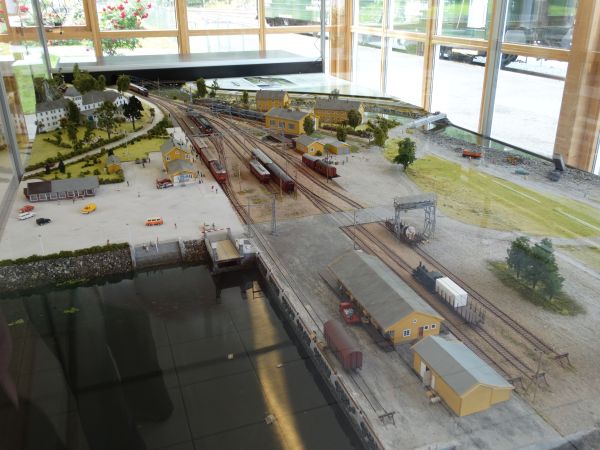
There is a skillfully built scale H0 (1:87) model diorama of the Flåm station area in the Flåmsbanamuseum, showing how the area looked like before the
incredible rush of tourists. The model is a bit tricky to photograph due to reflections from protective plexiglass plates. It's a nice piece of model
railroading though, but who the *beep* put that Stockholm local traffic train to Flåm? ;-) (In the background to the right is a German class 420 S-Bahn train
in the blue colours of SJ from a time when Stockholm's SJ rented them from Germany. It would be hard to believe they ever visited Flåm ? )
Picture from Flåm, from the Flåmsbana museum 2.7.2016 by Ilkka Siissalo.
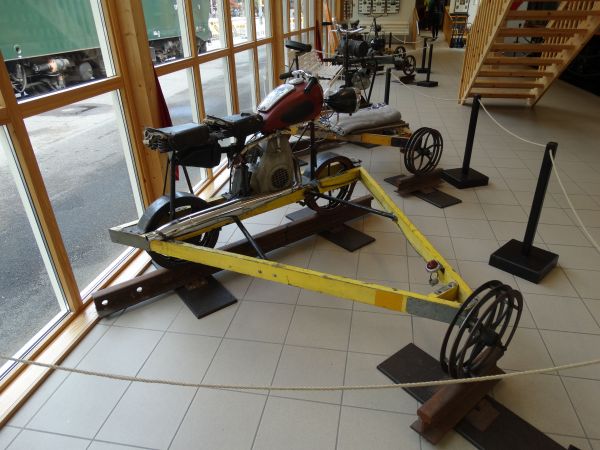
A rail moped at the Flåmsbanamuseum.
Picture from Flåm, from the Flåmsbana museum 2.7.2016 by Ilkka Siissalo.
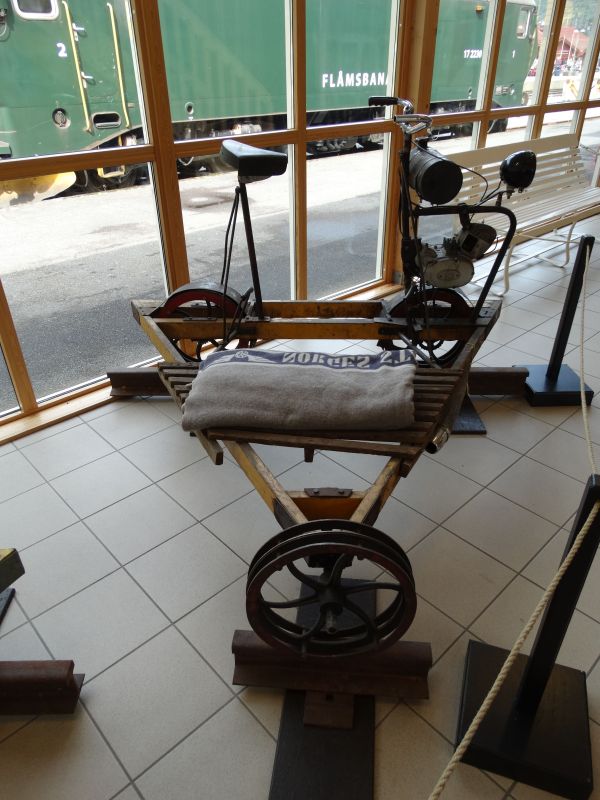
A draisine from the post-war times, powered by a gasoline driven "Solex type" auxiliary engine of a bike.
Picture from Flåm, from the Flåmsbana museum 2.7.2016 by Ilkka Siissalo.
Thamshavnbanen
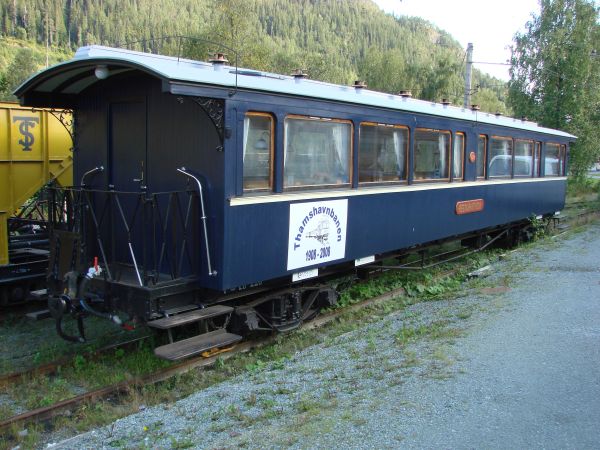
Already in the 1600s there was a mine and factory at Løkken near the city of Trondheim, producing pyrite. In 1896 the mine was bought by
Christian Thams, who then proceeded to set up turbines in the river nearby and built a metre gauge electric railway down to the harbour of Thamshavn.
It was electrified with 6,6 kV, 25 Hz AC, a very rare solution. The line is 25 km long. Passenger traffic on the line ended in 1963 and in
1974 the whole line was shut down. In 1983 the line was reopened as a heritage railway. This picture shows a dining car, which can be used
in touristric trains along the line.
Picture from Løkken 21.8.2008 by Ilkka Siissalo.
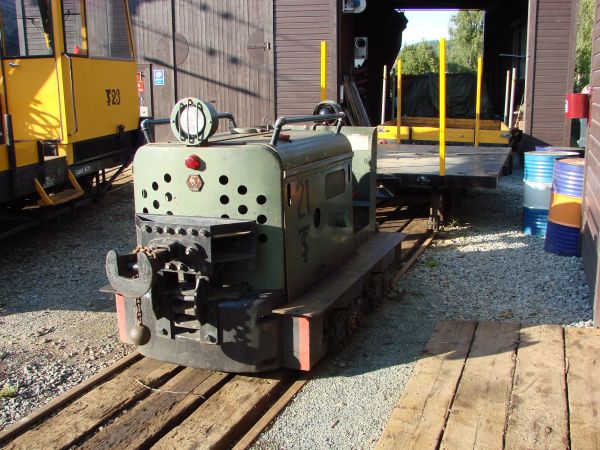
This small locomotive used to be moving pyrite ore wagons in the mine.
Picture from Løkken 21.8.2008 by Ilkka Siissalo.
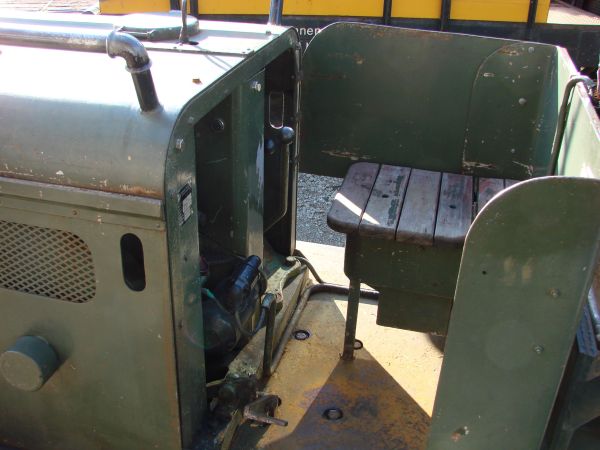
The controls to drive a mine locomotive were quite simple.
Picture from Løkken 21.8.2008 by Ilkka Siissalo.
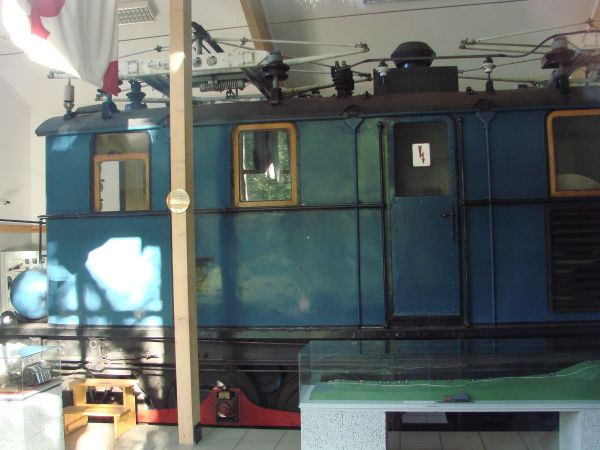
One of the old electric locomotives of Thamshavnbanen. Unfortunately it was only possible at the time to see a glimpse of it through a window,
but this must be either no. 7 or no. 8. Those were built by Asea in 1918.
Picture from Løkken 21.8.2008 by Ilkka Siissalo.
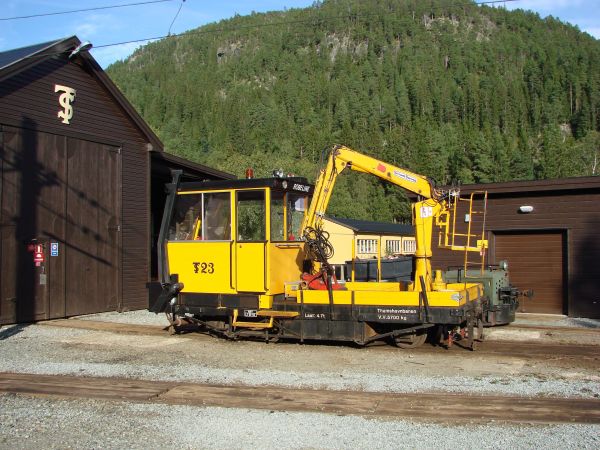
Today Thamshavnbanen has also some quite modern rolling stock to help with keeping the 25 km long line in good order. This is a Robel built
modern rail truck, named "Robeline".
Picture from Løkken 21.8.2008 by Ilkka Siissalo.
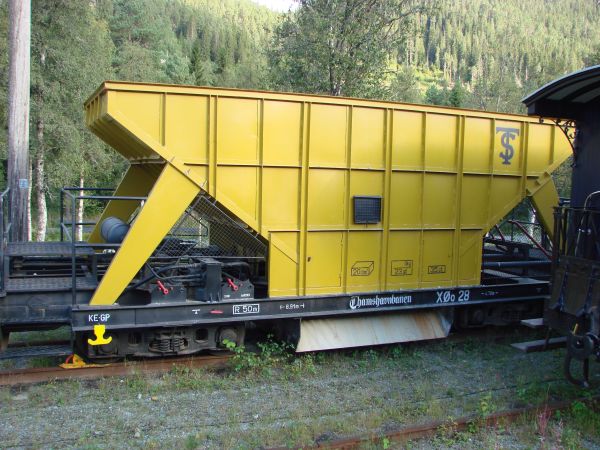
Thamshavnbanen's class XØo gravel and ballast wagons are probably Norway's only such wagons in metre gauge, especially since the only
metre gauge networks in the whole country are Thamshavnbanen and the Trondheim tram network. The wagons are made in Romania in 2005.
Picture from Løkken 21.8.2008 by Ilkka Siissalo.
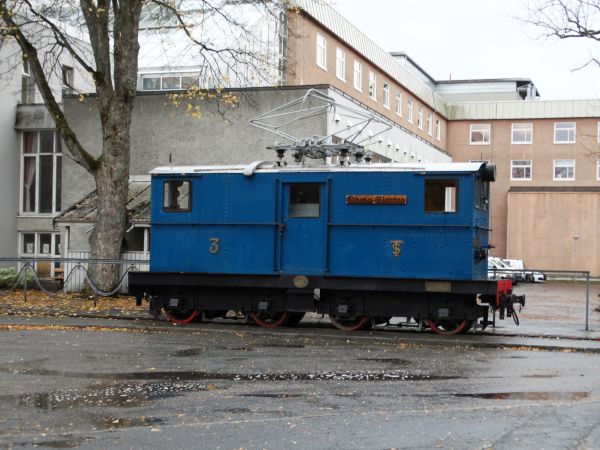
The "Ohma Electra" from Thamshavnsbanen is Norway's oldest electric locomotive. It was built in 1908 and used on the Thamshavnsbanen
until the 1950s. Nowadays it stands as a memorial in front of the technical university NTNU in Trondheim, where the local student
union takes good care of it.
Picture from NTNU in Trondheim 18.10.2018 by Ilkka Siissalo.
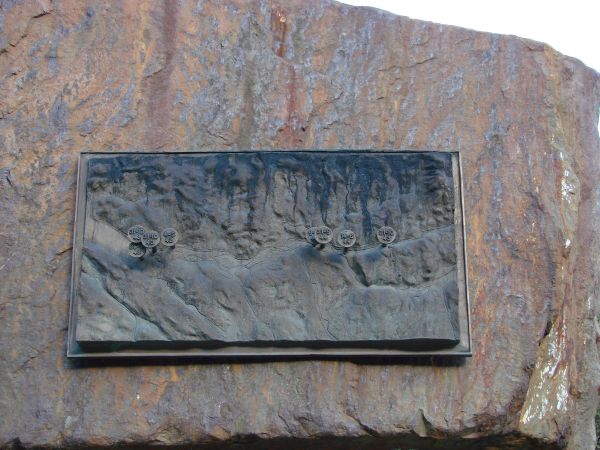
This is a memorial block of ore commemorating the numerous sabotage actions performed against Thamshavnbanen during the war. As Nazi Germany occupied Norway,
it was very important for the Germans to get the pyrite of the Løkken mines, as that was a source of sulphur and an ingredient needed
in explosives. The mining company was forced to cooperate with the Germans, but many resistance fighters wanted to stop Germany from aquiring
anything from the mine. One by one all of the locomotives and all railcars, except for one which was too weak to haul ore wagons, were exploded in numerous
sabotage actions.
Picture from Løkken 21.8.2008 by Ilkka Siissalo.
Motorhistorisk klubb Ringerike og omegn, Hønefoss
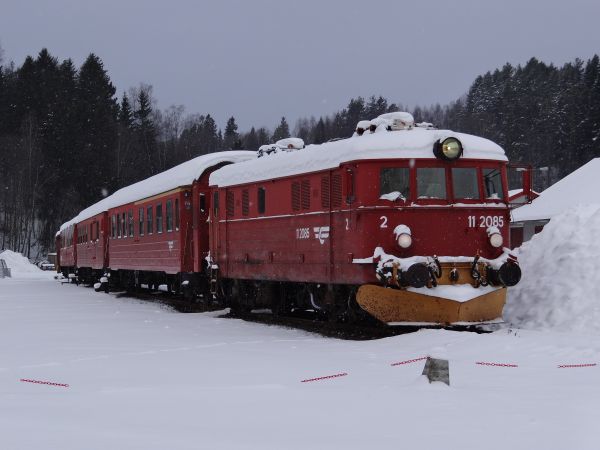
The Motorhistorisk klubb Ringerike og omegn located in the small town of Hønefoss in southern Norway has a number of historic locomotives and trains including this
class El 11 electric locomotive and its historic train. The type NSB El 11 was built by NEBB and Thune in two batches 1951 to 1956 and 1963 to 1964. It was a
105 km/h fast machine which had a power rating of 1676 kW. This one is from the first production batch.
Picture from Hønefoss station 19.1.2018 by Ilkka Siissalo.

